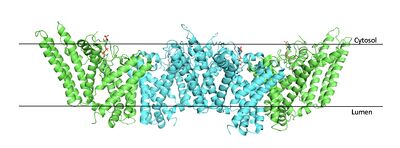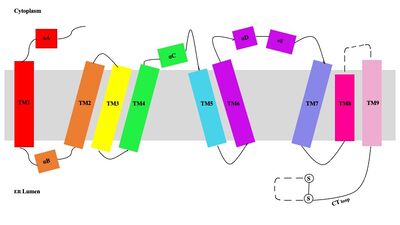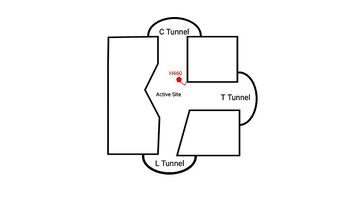User:Kaitlyn Roberts/Sandbox 2
From Proteopedia
< User:Kaitlyn Roberts(Difference between revisions)
| Line 3: | Line 3: | ||
== Functional Overview == | == Functional Overview == | ||
| - | [[Image:SOATfirstreaction.png|500 px|right|thumb|'''Figure 1. Esterification reaction of oleoyl-CoA and cholesterol catalyzed by SOAT.''']] Sterol O-acyltransferase(SOAT), otherwise known as Acyl-coenzyme A:cholesterol acyltransferase(ACAT), is the first discovered member of the membrane-bound O-acyl [https://en.wikipedia.org/wiki/Transferase transferase] or MBOAT enzyme group. MBOAT enzymes are responsible for the transfer of [https://en.wikipedia.org/wiki/Acyl_group acyl chains] onto multiple types of substrates within the cell. There are 11 MBOAT enzyme types that can be found in humans, all of which serve a different function in the overall makeup of human biology.<ref name="Guan">PMID:32424158</ref> | + | [[Image:SOATfirstreaction.png|500 px|right|thumb|'''Figure 1. Esterification reaction of oleoyl-CoA and cholesterol catalyzed by SOAT.''' This reaction results in the formation of cholesteryl esters and CoA-SH byproduct.]] Sterol O-acyltransferase(SOAT), otherwise known as Acyl-coenzyme A:cholesterol acyltransferase(ACAT), is the first discovered member of the membrane-bound O-acyl [https://en.wikipedia.org/wiki/Transferase transferase] or MBOAT enzyme group. MBOAT enzymes are responsible for the transfer of [https://en.wikipedia.org/wiki/Acyl_group acyl chains] onto multiple types of substrates within the cell. There are 11 MBOAT enzyme types that can be found in humans, all of which serve a different function in the overall makeup of human biology.<ref name="Guan">PMID:32424158</ref> |
SOAT specifically catalyzes the [https://en.wikipedia.org/wiki/Fischer–Speier_esterification esterification] of cholesterol for efficient storage within the cell (Figure 1). As a membrane lipid, [https://en.wikipedia.org/wiki/Cholesterol cholesterol] is responsible for controlling the fluidity and integrity of the membrane, along with other important biological processes. When there are high concentrations of cholesterol in the cell, [https://en.wikipedia.org/wiki/Cholesteryl_ester cholesteryl esters] can be formed for storage within the membrane.<ref name="Guan" /> | SOAT specifically catalyzes the [https://en.wikipedia.org/wiki/Fischer–Speier_esterification esterification] of cholesterol for efficient storage within the cell (Figure 1). As a membrane lipid, [https://en.wikipedia.org/wiki/Cholesterol cholesterol] is responsible for controlling the fluidity and integrity of the membrane, along with other important biological processes. When there are high concentrations of cholesterol in the cell, [https://en.wikipedia.org/wiki/Cholesteryl_ester cholesteryl esters] can be formed for storage within the membrane.<ref name="Guan" /> | ||
| Line 9: | Line 9: | ||
== Structure == | == Structure == | ||
=== Tertiary Structure === | === Tertiary Structure === | ||
| - | [[Image:Tetramerlabels.jpeg|400 px|right|thumb|'''Figure 2. Tetramer unit of SOAT shown in position within the membrane.''' The dimer units are identical, as indicated by the corresponding green and blue regions. [http://www.rcsb.org/structure/6P2P PBD 6P2P]]] The biological assembly of SOAT is a <scene name='87/877559/Tetramer_final/2'>tetramer</scene> or a <scene name='87/877559/Dimer_of_dimers_final/2'>dimer of dimers</scene> (Figure 2). Functionally, the <scene name='87/877559/Dimer_final/1'>dimer</scene> units of SOAT are identical and are stabilized by hydrophobic [https://en.wikipedia.org/wiki/Van_der_Waals_force van der Waals interactions] between residues at the <scene name='87/877559/Dimer_interface_final/1'>dimer interface</scene>. Mutating these residues inhibits enzyme activity, suggesting that the dimer unit of SOAT is critical for enzyme function.<ref name="Guan" /> Each dimer consists of two identical <scene name='87/877559/Monomer/7'>monomer</scene> units, individually made up of nine <scene name='87/877559/Transmembrane_helices_final/4'>transmembrane helices</scene> labeled TM1 through TM9 (Figure 3). [[Image:Helicesdiagram1.jpeg|400 px|right|thumb|'''Figure 3. Labeled helices of SOAT within the membrane''']] The van der Waals interactions at the dimer interface stabilize the dimer between the TM1 helix of one monomer unit and the TM6 [https://en.wikipedia.org/wiki/Lumen_(anatomy) lumenal] segment and TM9 [https://en.wikipedia.org/wiki/Cytosol cytosolic] segment of the other monomer unit. Essential helices (TM1, TM5, TM6, and TM9) from the two monomers form the entrance tunnels and catalytic active site.<ref name="Qian">PMID:32433614</ref> | + | [[Image:Tetramerlabels.jpeg|400 px|right|thumb|'''Figure 2. Tetramer unit of SOAT shown in position within the membrane.''' The dimer units are identical, as indicated by the corresponding green and blue regions. [http://www.rcsb.org/structure/6P2P PBD 6P2P]]] The biological assembly of SOAT is a <scene name='87/877559/Tetramer_final/2'>tetramer</scene> or a <scene name='87/877559/Dimer_of_dimers_final/2'>dimer of dimers</scene> (Figure 2). Functionally, the <scene name='87/877559/Dimer_final/1'>dimer</scene> units of SOAT are identical and are stabilized by hydrophobic [https://en.wikipedia.org/wiki/Van_der_Waals_force van der Waals interactions] between residues at the <scene name='87/877559/Dimer_interface_final/1'>dimer interface</scene>. Mutating these residues inhibits enzyme activity, suggesting that the dimer unit of SOAT is critical for enzyme function.<ref name="Guan" /> Each dimer consists of two identical <scene name='87/877559/Monomer/7'>monomer</scene> units, individually made up of nine <scene name='87/877559/Transmembrane_helices_final/4'>transmembrane helices</scene> labeled TM1 through TM9 (Figure 3). [[Image:Helicesdiagram1.jpeg|400 px|right|thumb|'''Figure 3. Labeled helices of SOAT within the membrane.''']] The van der Waals interactions at the dimer interface stabilize the dimer between the TM1 helix of one monomer unit and the TM6 [https://en.wikipedia.org/wiki/Lumen_(anatomy) lumenal] segment and TM9 [https://en.wikipedia.org/wiki/Cytosol cytosolic] segment of the other monomer unit. Essential helices (TM1, TM5, TM6, and TM9) from the two monomers form the entrance tunnels and catalytic active site.<ref name="Qian">PMID:32433614</ref> |
=== Tunnel System === | === Tunnel System === | ||
| Line 26: | Line 26: | ||
== Inhibitors == | == Inhibitors == | ||
| - | [[Image:InhibitorCI976.jpeg|300 px|right|thumb|'''Figure 6. Structure of the CI-976 inhibitor''']] Depending on concentration and exposure, SOAT activity can be inhibited by CI-976 (Figure 6). When exposed, CI-976 locks itself in the <scene name='87/877559/Inhibitor_in_active_site_final/1'>catalytic center</scene> of the enzyme. The <scene name='87/877559/Residues_and_inhibitor/20'>trimethoxyphenyl head</scene> becomes sandwiched between the catalytic residues W420, N421, and H460. The interaction with these residues, as well as the location of the trimethoxyphenyl head, indicate that CI-976 acts as a [https://en.wikipedia.org/wiki/Competitive_inhibition competitive inhibitor] of SOAT by preventing substrates from accessing the catalytic center. Similar to interactions with the substrates, mutating the key catalytic residues (N421A, H460A, and H460N) results in a smaller effect of the inhibitor on the thermostability of the enzyme.<ref name="Guan" /> | + | [[Image:InhibitorCI976.jpeg|300 px|right|thumb|'''Figure 6. Structure of the CI-976 inhibitor.''']] Depending on concentration and exposure, SOAT activity can be inhibited by CI-976 (Figure 6). When exposed, CI-976 locks itself in the <scene name='87/877559/Inhibitor_in_active_site_final/1'>catalytic center</scene> of the enzyme. The <scene name='87/877559/Residues_and_inhibitor/20'>trimethoxyphenyl head</scene> becomes sandwiched between the catalytic residues W420, N421, and H460. The interaction with these residues, as well as the location of the trimethoxyphenyl head, indicate that CI-976 acts as a [https://en.wikipedia.org/wiki/Competitive_inhibition competitive inhibitor] of SOAT by preventing substrates from accessing the catalytic center. Similar to interactions with the substrates, mutating the key catalytic residues (N421A, H460A, and H460N) results in a smaller effect of the inhibitor on the thermostability of the enzyme.<ref name="Guan" /> |
== Biological Relevance == | == Biological Relevance == | ||
Current revision
Human Sterol O-acyltransferase
| |||||||||||
References
- ↑ 1.0 1.1 1.2 1.3 1.4 1.5 1.6 Guan C, Niu Y, Chen SC, Kang Y, Wu JX, Nishi K, Chang CCY, Chang TY, Luo T, Chen L. Structural insights into the inhibition mechanism of human sterol O-acyltransferase 1 by a competitive inhibitor. Nat Commun. 2020 May 18;11(1):2478. doi: 10.1038/s41467-020-16288-4. PMID:32424158 doi:http://dx.doi.org/10.1038/s41467-020-16288-4
- ↑ 2.0 2.1 2.2 2.3 Qian H, Zhao X, Yan R, Yao X, Gao S, Sun X, Du X, Yang H, Wong CCL, Yan N. Structural basis for catalysis and substrate specificity of human ACAT1. Nature. 2020 May;581(7808):333-338. doi: 10.1038/s41586-020-2290-0. Epub 2020 May, 13. PMID:32433614 doi:http://dx.doi.org/10.1038/s41586-020-2290-0
- ↑ Das A, Davis MA, Rudel LL. Identification of putative active site residues of ACAT enzymes. J Lipid Res. 2008 Aug;49(8):1770-81. doi: 10.1194/jlr.M800131-JLR200. Epub 2008, May 13. PMID:18480028 doi:http://dx.doi.org/10.1194/jlr.M800131-JLR200
- ↑ Guo ZY, Lin S, Heinen JA, Chang CC, Chang TY. The active site His-460 of human acyl-coenzyme A:cholesterol acyltransferase 1 resides in a hitherto undisclosed transmembrane domain. J Biol Chem. 2005 Nov 11;280(45):37814-26. doi: 10.1074/jbc.M508384200. Epub 2005, Sep 8. PMID:16154994 doi:http://dx.doi.org/10.1074/jbc.M508384200
- ↑ 5.0 5.1 Bhattacharyya R, Kovacs DM. ACAT inhibition and amyloid beta reduction. Biochim Biophys Acta. 2010 Aug;1801(8):960-5. doi: 10.1016/j.bbalip.2010.04.003. , Epub 2010 Apr 14. PMID:20398792 doi:http://dx.doi.org/10.1016/j.bbalip.2010.04.003
- ↑ 6.0 6.1 Huttunen HJ, Kovacs DM. ACAT as a drug target for Alzheimer's disease. Neurodegener Dis. 2008;5(3-4):212-4. doi: 10.1159/000113705. Epub 2008 Mar 6. PMID:18322393 doi:http://dx.doi.org/10.1159/000113705
- ↑ Chang C, Dong R, Miyazaki A, Sakashita N, Zhang Y, Liu J, Guo M, Li BL, Chang TY. Human acyl-CoA:cholesterol acyltransferase (ACAT) and its potential as a target for pharmaceutical intervention against atherosclerosis. Acta Biochim Biophys Sin (Shanghai). 2006 Mar;38(3):151-6. doi:, 10.1111/j.1745-7270.2006.00154.x. PMID:16518538 doi:http://dx.doi.org/10.1111/j.1745-7270.2006.00154.x
- ↑ Ayyagari VN, Wang X, Diaz-Sylvester PL, Groesch K, Brard L. Assessment of acyl-CoA cholesterol acyltransferase (ACAT-1) role in ovarian cancer progression-An in vitro study. PLoS One. 2020 Jan 24;15(1):e0228024. doi: 10.1371/journal.pone.0228024., eCollection 2020. PMID:31978092 doi:http://dx.doi.org/10.1371/journal.pone.0228024
Student Contributors
- Kylie Pfeifer
- Stephanie Pellegrino
- Kaitlyn Roberts






